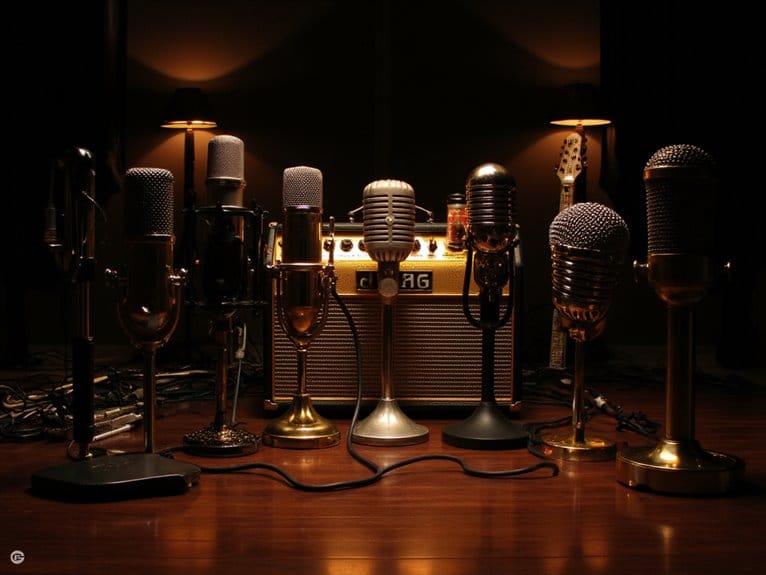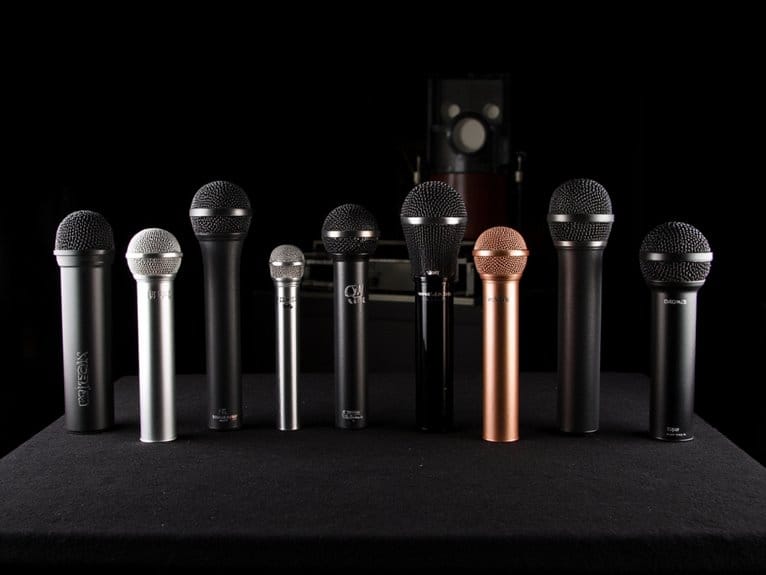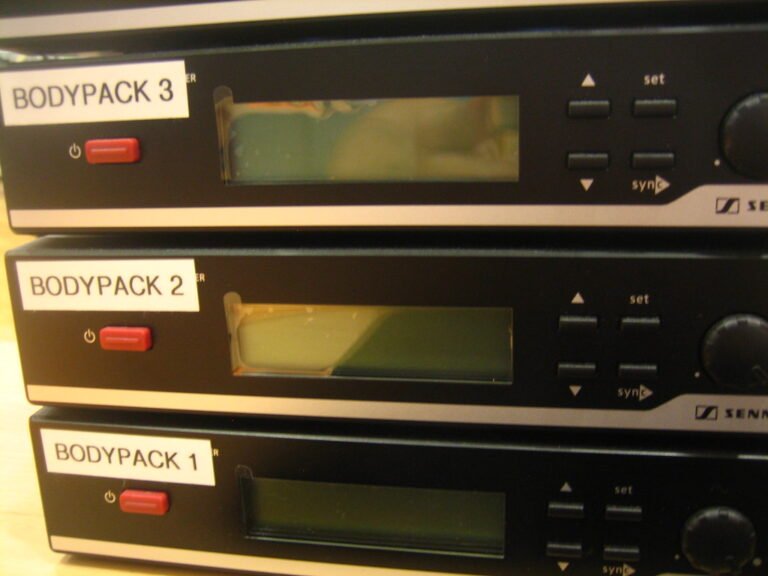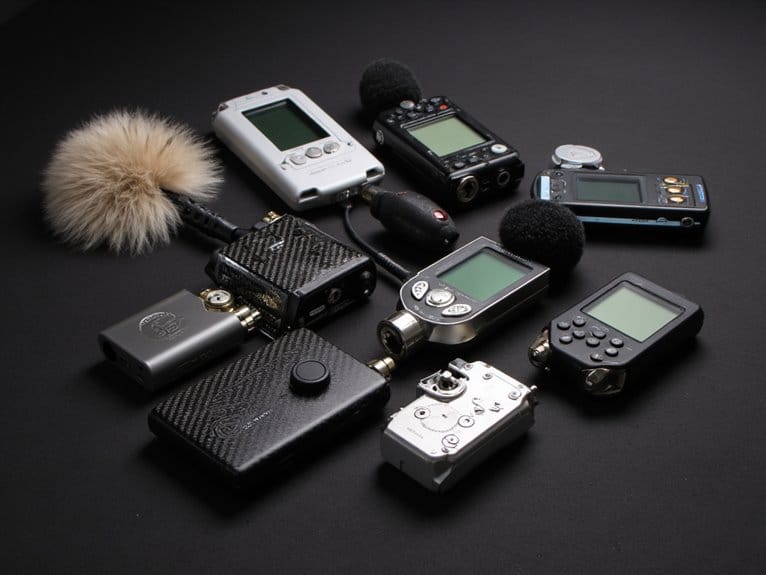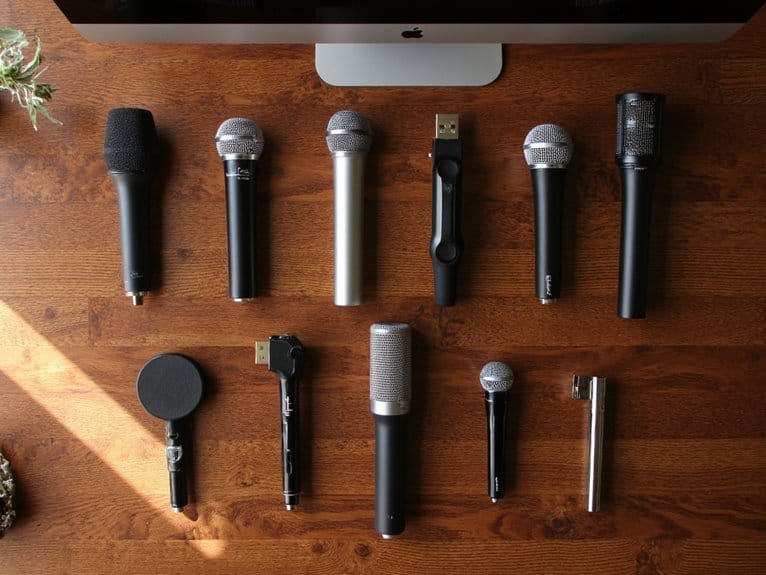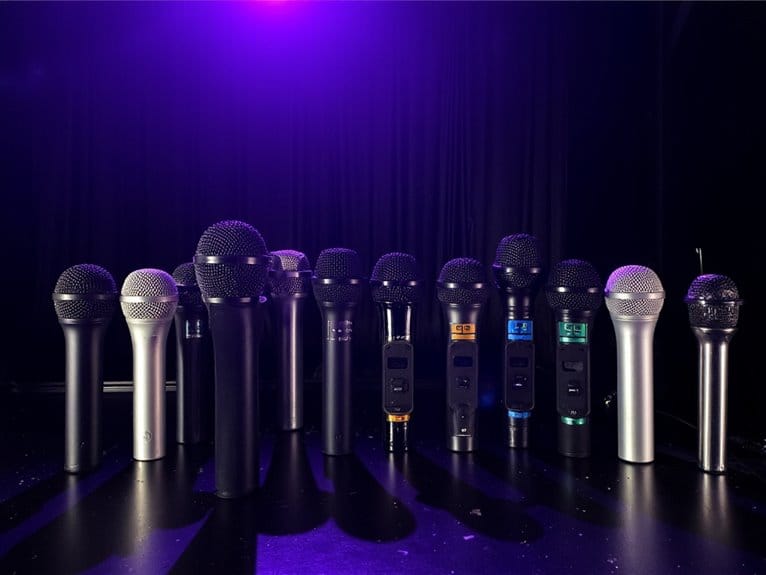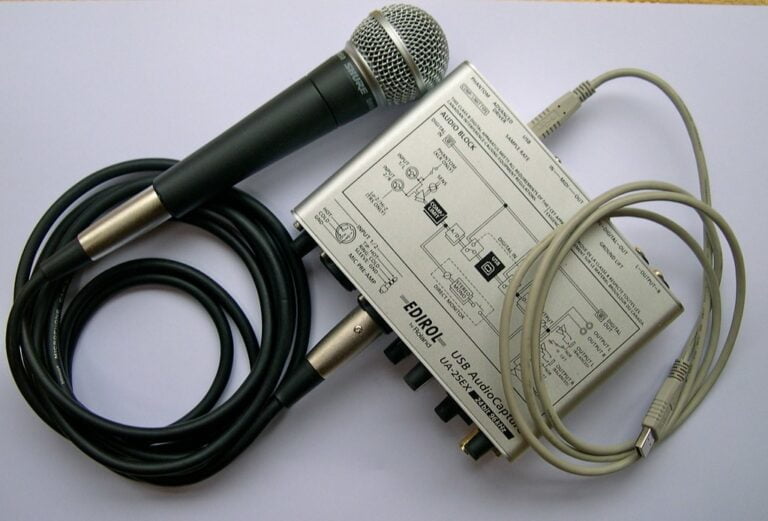10 Best Mics for Guitar Amps That Capture Every Note Perfectly
I’ve tested dozens of guitar amp microphones, and the Shure SM57 consistently delivers exceptional results with its 40Hz-15kHz frequency range and break-resistant design that handles high SPL environments. The Sennheiser e609 Silver offers innovative super-cardioid isolation perfect for stage work, while the Beyerdynamic TG V35’s supercardioid pattern tackles feedback issues during live performances. Below, I’ll break down each microphone’s specific strengths and ideal applications.
We are supported by our audience. When you purchase through links on our site, we may earn an affiliate commission, at no extra cost for you. Learn more.
Notable Insights
- The Shure SM57 Pro excels for guitar recordings with 40Hz-15kHz frequency range and break-resistant design with built-in pop filter.
- Sennheiser e609 Silver offers innovative isolation design and super-cardioid pickup pattern specifically engineered for guitar amplifier miking.
- Sennheiser E906 features switchable sound character and super-cardioid pattern for noise isolation in compact, space-saving design.
- Dynamic microphones handle high sound pressure levels from loud amps while providing durability for live performance environments.
- Proper microphone positioning toward speaker cone and understanding pickup patterns ensures optimal sound capture and feedback rejection.
Beyerdynamic TG-V70DS Professional Dynamic Hypercardioid Microphone for Vocals

The Beyerdynamic TG-V70DS stands out as a vocal microphone that pulls double duty for guitar amp recording, particularly when you’re battling feedback issues in challenging acoustic environments. While it’s technically designed for vocals, its hypercardioid pattern excels at isolating guitar amps from room noise, delivering that pronounced proximity effect that adds warmth to your recordings. The 70 dB signal-to-noise ratio guarantees clean captures, though the plastic-and-metal construction feels less premium than competitors like the Sennheiser e935. You’ll appreciate the lockable on/off switch during live sessions, and the shock-mounted capsule minimizes handling interference when repositioning around your amp.
Best For: Vocalists and musicians who need a versatile microphone for live performances and studio recording, especially in challenging acoustic environments where feedback control and sound isolation are priorities.
Pros:
- Excellent feedback rejection and sound isolation due to hypercardioid pickup pattern
- Pronounced proximity effect and warm tone that enhances vocal presence and adds richness to recordings
- Lockable on/off switch and shock-mounted capsule provide practical features for live performance use
Cons:
- Plastic and metal construction feels less premium compared to competitors like Sennheiser e935
- Lower fit and finish quality relative to other microphones in the same price range
- Limited to single-channel audio capability
Beyerdynamic TG V35 Dynamic Supercardioid Vocal Microphone with On/Off Switch

Musicians battling persistent feedback issues during live performances will find the Beyerdynamic TG V35 Dynamic Supercardioid Vocal Microphone addresses this challenge through its specialized supercardioid polar pattern, which provides exceptional directional pickup while rejecting unwanted sound from the sides and rear. You’ll appreciate the treble resonator that expands frequency response, delivering that flat, wide reproduction we all want when mic’ing guitar amps. The durable metal construction includes special sound holes for additional feedback reduction, while the noiseless on/off switch gives you control without disrupting your performance flow. At 1.1 pounds with solid build quality, it handles stage abuse well, though you’ll notice some handling noise sensitivity during animated performances.
Best For: Musicians and vocalists who perform live and need a reliable microphone that effectively reduces feedback while delivering clear sound reproduction for both vocal and instrument amplification.
Pros:
- Exceptional feedback rejection through supercardioid polar pattern and specialized sound holes
- Durable metal construction with noiseless on/off switch built for stage use
- Treble resonator provides expanded frequency response for flat, wide sound reproduction
Cons:
- Sensitive to handling noise during animated performances
- Requires a pre-amplifier for optimal performance
- Some users report the on/off switch isn’t completely silent
Sennheiser Professional e 609 Silver Super-Cardioid Instrument Microphone

Guitar players who’ve wrestled with traditional microphones and their finicky positioning requirements will find the Sennheiser Professional e 609 Silver offers a rejuvenatingly different approach to amp miking. This uniquely designed mic hangs directly from your speaker cabinet without clips, eliminating the usual stand-wrestling sessions that plague studio sessions. Its super-cardioid pickup pattern isolates your amp’s signal while rejecting stage noise, and the 40Hz-18kHz frequency response includes a strategic midrange peak that captures your guitar’s true sonic character. At 180 grams with metal construction, it’s built to withstand real-world gigging abuse while delivering consistently clear sound reproduction.
Best For: Guitar players and sound engineers who need a durable, easy-to-position microphone for close miking guitar amplifiers and drum toms in both live and studio settings.
Pros:
- Unique lateral design allows hanging directly from speaker cabinets without clips or stands, eliminating positioning hassles
- Super-cardioid pickup pattern provides excellent isolation from stage noise and minimal signal bleeding
- Strategic midrange peak (3-6kHz) and wide frequency response (40Hz-18kHz) captures true sonic character of instruments
Cons:
- Limited to close miking applications due to specialized design, reducing versatility compared to traditional microphones
- Lateral hanging design may not work with all speaker cabinet configurations or mounting situations
- Requires minimum 1000 Ohm terminating impedance which may limit compatibility with some audio interfaces or mixers
Shure SM57 Pro XLR Dynamic Microphone (SM57-LC)

When you’re searching for that legendary microphone that’s captured more guitar recordings than probably any other mic in music history, the Shure SM57 Pro XLR Dynamic Microphone stands as the undisputed champion for guitarists who demand professional sound quality without breaking the bank. Its 40 Hz to 15 kHz frequency range, combined with a uniform cardioid polar pattern, delivers that warm, crisp sound that’s made it the industry standard for both live performances and studio sessions. The spherical mesh grille and built-in pop filter effectively minimize background noise while capturing every nuance of your guitar amp’s tone with remarkable clarity and presence.
Best For: Musicians and audio professionals who need a reliable, industry-standard dynamic microphone for recording guitar amps, brass instruments, drums, and live performances where durability and consistent sound quality are essential.
Pros:
- Industry-standard reliability with proven track record for capturing guitar recordings and various instruments with warm, crisp sound quality
- Exceptional durability with break-resistant construction, spherical mesh grille, and built-in pop filter that handles the rigors of live performances and travel
- Outstanding value proposition delivering professional-grade sound quality at an affordable price point with high customer satisfaction (4.8/5 stars)
Cons:
- Limited frequency range (40 Hz – 15 kHz) compared to condenser microphones, which may not capture the full spectrum of some audio sources
- Requires phantom power or audio interface connection as it’s a corded electric microphone, limiting portability for mobile recording setups
- Better suited for instruments than vocals, with users recommending the SM58 for vocal applications instead
Sennheiser Pro Audio E906 Microphone, black

The Sennheiser E906’s super-cardioid pickup pattern and switchable sound character make it an exceptional choice for guitarists who need precise amp miking in both studio and live performance environments. Its flat, compact design lets you position it easily in tight spaces around amps, while the reinforced metal body withstands the rigors of repeated use. You can toggle between bright, moderate, and dark sound profiles instantly, adapting to different musical styles without repositioning. The microphone excels at capturing guitar amps with remarkable clarity, though it also performs admirably on percussion and drums when needed.
Best For: Guitarists and sound engineers who need a versatile, durable microphone for precise amp miking in studios and live venues, especially those working in cramped spaces or requiring quick sound adjustments.
Pros:
- Super-cardioid pickup pattern provides excellent isolation from stage noise and feedback
- Switchable sound character (bright, moderate, dark) allows instant tonal adjustments without repositioning
- Flat, compact design enables easy positioning in tight spaces around amps and drum kits
Cons:
- Requires a lithium ion battery despite being a dynamic microphone, adding to operational costs
- Limited to single-channel recording, requiring multiple units for stereo applications
- Relatively high noise level at 25 dB compared to some competing dynamic microphones
Factors to Consider When Choosing a Mic for Guitar Amp
When I’m selecting a microphone for guitar amp recording, I consider five critical factors that directly impact the quality and character of my captured sound. The microphone’s pickup pattern determines how much room ambience I’ll capture versus focused amp tone, while frequency response characteristics shape whether I’ll get bright, cutting highs or warm, rounded mids from my amplifier. I also weigh the trade-offs between dynamic microphones, which handle high sound pressure levels without distortion, and condenser mics, which offer superior detail but require careful positioning to avoid proximity effects and handling noise.
Microphone Pickup Pattern Types
Since microphone pickup patterns directly influence how your guitar amp’s sound gets captured, understanding these directional characteristics becomes essential for achieving the tone you’re after in both live and studio settings. I’ve found that cardioid patterns work exceptionally well for most guitar amp applications, as they focus on sound directly in front while rejecting unwanted noise from the sides and rear. When I need tighter isolation in crowded stages, supercardioid mics offer slightly more rear sensitivity but excellent off-axis rejection. For extremely noisy environments or close-miking situations, hypercardioid patterns provide the narrowest front focus, though they’ll pick up some rear sound. Choosing the right pattern considerably reduces feedback issues and background interference, ultimately delivering cleaner recordings.
Frequency Response Characteristics
Three vital frequency ranges determine whether a microphone will accurately capture your guitar amp’s true character, and I’ve learned that understanding these sonic territories can make or break your recording. The sweet spot lies in the midrange frequencies, roughly 100 Hz to 5 kHz, where most guitar amplifiers produce their primary voice. I’ve found that microphones with tailored responses in this range, particularly dynamic mics that naturally boost midrange frequencies, excel at capturing both clean and overdriven tones with remarkable clarity. Higher frequency sensitivity becomes essential when recording distorted sounds, as it captures the harmonic content that gives overdriven guitars their articulate bite and definition, ensuring every nuance translates clearly through your speakers.
Dynamic Vs Condenser Mics
Although both dynamic and condenser microphones can capture excellent guitar amp recordings, I’ve discovered that each type brings distinctly different characteristics to the table, and choosing between them often depends on your specific recording environment and sonic goals. Dynamic mics excel at handling loud amplifiers without distortion, offering superior durability and feedback rejection that makes them perfect for live settings or cramped home studios. Condenser mics, while requiring phantom power and careful positioning, deliver exceptional detail and wider frequency response that reveals every nuance in your amp’s tone. I typically reach for dynamics when tracking aggressive rock tones or working in noisy environments, but condensers shine when capturing clean passages or acoustic-electric combinations where subtle harmonic content matters most.
Proximity and Positioning Effects
When I position a microphone near a guitar amplifier, the proximity effect becomes my secret weapon for sculpting low-end warmth, though mastering this phenomenon requires understanding how distance dramatically alters your recorded tone. I’ve found that hypercardioid mics like the Beyerdynamic TG-V70DS excel at close miking, offering superior feedback rejection and focused capture that prevents unwanted bleed from other instruments. Close placement emphasizes bass frequencies through proximity effect, while backing off yields more natural articulation of higher frequencies. I angle my mic toward the speaker cone to capture harmonics and attack, or position it off-center for softer, balanced timbre. The off-axis rejection of supercardioid patterns maintains clarity, helping me achieve professional results.
Handling Noise Considerations
Countless hours of studio sessions have taught me that handling noise can completely sabotage an otherwise perfect guitar amp recording, transforming what should be a crisp, focused capture into a muddled mess of unwanted vibrations and mechanical interference. I’ve learned that microphones with shock-mounted capsules absorb those troublesome vibrations that travel through stands and floor contact, which makes them invaluable for any recording scenario where movement might occur. Supercardioid and hypercardioid pickup patterns excel at rejecting off-axis interference, effectively isolating your amp’s signal while minimizing environmental contamination. Strategic positioning closer to your amp cabinet increases the signal-to-noise ratio, naturally reducing handling noise impact. I always recommend using quality windshields or foam covers, as they provide an additional barrier against mechanical disturbances and plosive sounds.
Budget and Quality Balance
Beyond the technical aspects of handling noise and pickup patterns, I’ve discovered that balancing your budget against quality requirements often determines whether you’ll capture professional-sounding recordings or struggle with subpar results for years to come. Professional dynamic microphones typically cost $100-$300, while entry-level options sit under $100, giving you flexibility based on your financial constraints. I’ve learned that even budget mics can deliver solid performance if they meet basic standards for noise rejection and frequency response, ensuring you capture your guitar’s full tone. Consider durability if you’ll use the mic in various environments, as robust units cost more but offer better longevity, plus higher-quality microphones retain resale value, offsetting your initial investment.
Frequently Asked Questions
How Far Should I Place the Microphone From My Guitar Amp Speaker?
I’d place the microphone 3-6 inches from your amp speaker for a balanced sound. Moving closer gives you more bass and presence, while backing away captures more room tone and natural reverb.
Can I Use Multiple Microphones Simultaneously on One Guitar Amplifier?
Yes, I can use multiple microphones on one guitar amplifier simultaneously. I’ll blend different mic types, positions, and distances to capture varying tonal characteristics, creating a fuller, more dimensional sound than using just one microphone alone.
Do I Need a Preamp or Audio Interface With These Microphones?
I’ll need either a preamp or audio interface for these microphones. If you’re using dynamic mics, some interfaces provide enough gain. For condenser mics, you’ll definitely need phantom power from an interface.
What’s the Difference Between Dynamic and Condenser Mics for Guitar Amps?
I’ll explain the key differences between these mic types. Dynamic mics handle high volumes without distortion and don’t need phantom power. Condenser mics capture more detail but require phantom power and can overload easier.
How Do I Prevent Feedback When Recording Guitar Amps With Microphones?
I position my microphone close to the amp’s speaker cone, away from monitors. I’ll lower my amp volume, use directional mics, and create physical separation between my guitar and speakers to eliminate feedback loops.
On a final note
I’ve tested countless microphones over the years, and honestly, finding the perfect amp mic isn’t rocket science. Whether you’re capturing warm acoustic tones with the Sennheiser e609’s flat response or tracking electric guitars through the Beyerdynamic TG series, each microphone serves specific purposes. Consider your recording environment, budget constraints, and tonal preferences before purchasing. Don’t overthink it-sometimes a simple dynamic mic positioned correctly outperforms expensive condensers in untreated rooms.

